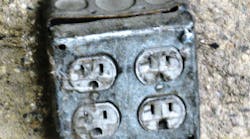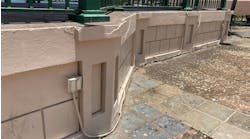How well do you know the Code? Think you can spot violations the original installer either ignored or couldn’t identify? Here’s your chance to moonlight as an electrical inspector and second-guess someone else’s work from the safety of your living room or office. Can you identify the Code violation(s) in this photo?
Hint: Battered and bruised outside
Find the Answer
‘Tell Them What They’ve Won...’
Using the 2008 NEC, correctly identify the Code violation(s) in this month’s photo — in 200 words or less — and you could win something to put in your toolbox. E-mail your response to [email protected], and we’ll select three winners (excluding manufacturers and prior winners) at random from the correct submissions. Winners will receive a set of insulated hand tools from Ideal Industries, Inc., valued at more than $125.* The set includes 9.25-in. insulated side-cutting pliers, 10-in. insulated tongue-and-groove pliers, and a 0.25-in. 3 6-in. insulated screwdriver. (* Please allow six to eight weeks for delivery of tools.)
FEBRUARY WINNERS
Our three winners this month include: Wade Johnson, president of Wade’s Electrical Service, Inc. in Moorhead, Minn.; Vince Viott, an electrician with Kissel Electric in Monument, Colo.; and Scott Walton, a project manager with Hilscher-Clarke Electric Co. in Canton, Ohio.
This picture clearly shows a watertight pin and sleeve receptacle mounted upside down. It’s obvious this type of mounting arrangement will allow water to get inside the device.
The first violation we can cite is in Art. 110. As noted in 110.3(B), “Listed or labeled equipment shall be installed and used in accordance with any instructions in the listing or labeling.” I think we can all agree this receptacle is not listed for use as an ash tray, nor is it intended to be installed upside down.
We can also reference Art. 314. As noted in 314.15, “In damp or wet locations, boxes, conduit bodies, and fittings shall be placed or equipped so as to prevent moisture from entering or accumulating within the box, conduit body, or fitting. Boxes, conduit bodies, and fittings installed in wet locations shall be listed for use in wet locations.”
In addition, the white/gray pipe in the lower right area of the photo appears to be a stair rail. If there are steps and a railing directly in front of these components, then we can also cite a violation of the working space requirements of 110.26.



